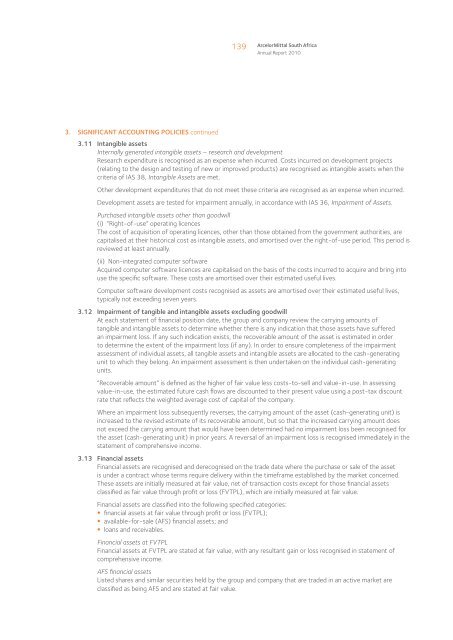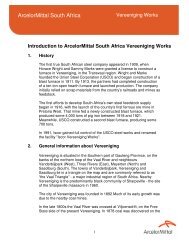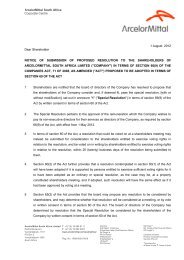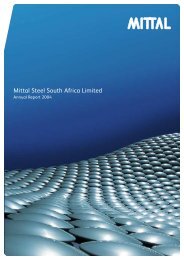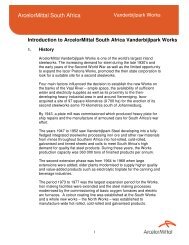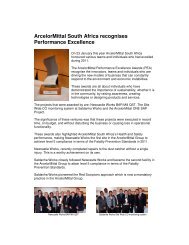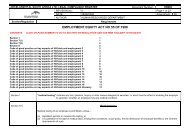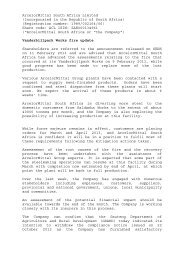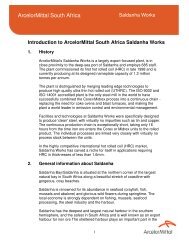bold spirit - ArcelorMittal South Africa
bold spirit - ArcelorMittal South Africa
bold spirit - ArcelorMittal South Africa
You also want an ePaper? Increase the reach of your titles
YUMPU automatically turns print PDFs into web optimized ePapers that Google loves.
139<br />
<strong>ArcelorMittal</strong> <strong>South</strong> <strong>Africa</strong><br />
Annual Report 2010<br />
3. SIGNIFICANT ACCOUNTING POLICIES continued<br />
3.11 Intangible assets<br />
Internally generated intangible assets – research and development<br />
Research expenditure is recognised as an expense when incurred. Costs incurred on development projects<br />
(relating to the design and testing of new or improved products) are recognised as intangible assets when the<br />
criteria of IAS 38, Intangible Assets are met.<br />
Other development expenditures that do not meet these criteria are recognised as an expense when incurred.<br />
Development assets are tested for impairment annually, in accordance with IAS 36, Impairment of Assets.<br />
Purchased intangible assets other than goodwill<br />
(i) “Right-of-use” operating licences<br />
The cost of acquisition of operating licences, other than those obtained from the government authorities, are<br />
capitalised at their historical cost as intangible assets, and amortised over the right-of-use period. This period is<br />
reviewed at least annually.<br />
(ii) Non-integrated computer software<br />
Acquired computer software licences are capitalised on the basis of the costs incurred to acquire and bring into<br />
use the specific software. These costs are amortised over their estimated useful lives.<br />
Computer software development costs recognised as assets are amortised over their estimated useful lives,<br />
typically not exceeding seven years.<br />
3.12 Impairment of tangible and intangible assets excluding goodwill<br />
At each statement of financial position date, the group and company review the carrying amounts of<br />
tangible and intangible assets to determine whether there is any indication that those assets have suffered<br />
an impairment loss. If any such indication exists, the recoverable amount of the asset is estimated in order<br />
to determine the extent of the impairment loss (if any). In order to ensure completeness of the impairment<br />
assessment of individual assets, all tangible assets and intangible assets are allocated to the cash-generating<br />
unit to which they belong. An impairment assessment is then undertaken on the individual cash-generating<br />
units.<br />
“Recoverable amount” is defined as the higher of fair value less costs-to-sell and value-in-use. In assessing<br />
value-in-use, the estimated future cash flows are discounted to their present value using a post-tax discount<br />
rate that reflects the weighted average cost of capital of the company.<br />
Where an impairment loss subsequently reverses, the carrying amount of the asset (cash-generating unit) is<br />
increased to the revised estimate of its recoverable amount, but so that the increased carrying amount does<br />
not exceed the carrying amount that would have been determined had no impairment loss been recognised for<br />
the asset (cash-generating unit) in prior years. A reversal of an impairment loss is recognised immediately in the<br />
statement of comprehensive income.<br />
3.13 Financial assets<br />
Financial assets are recognised and derecognised on the trade date where the purchase or sale of the asset<br />
is under a contract whose terms require delivery within the timeframe established by the market concerned.<br />
These assets are initially measured at fair value, net of transaction costs except for those financial assets<br />
classified as fair value through profit or loss (FVTPL), which are initially measured at fair value.<br />
Financial assets are classified into the following specified categories:<br />
• financial assets at fair value through profit or loss (FVTPL);<br />
• available-for-sale (AFS) financial assets; and<br />
• loans and receivables.<br />
Financial assets at FVTPL<br />
Financial assets at FVTPL are stated at fair value, with any resultant gain or loss recognised in statement of<br />
comprehensive income.<br />
AFS financial assets<br />
Listed shares and similar securities held by the group and company that are traded in an active market are<br />
classified as being AFS and are stated at fair value.


